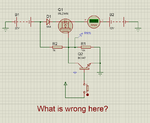Follow along with the video below to see how to install our site as a web app on your home screen.
Note: This feature may not be available in some browsers.
Hi,
the fet switches ON when gate voltage is about 4V (look at datasheet for exact value) above source voltage.
Source voltage is 12V (battery)
So you need 16V at gate.
But it is about 10V when button is not pressed and about 0V when button is pressed.
Never above 16V. --> No current.
******************
If you don´t use R1 then voltage is about 20V when button is not pressed and 0V when button is pressed.
So current will fow when button is not pressed.
*********
Use a P-Ch FET and exchange source and drain. but don´t forget to limit gate-source voltage. ...Ah i just saw that here R1 is usefull, it limits gate source to about 10V.
Klaus
